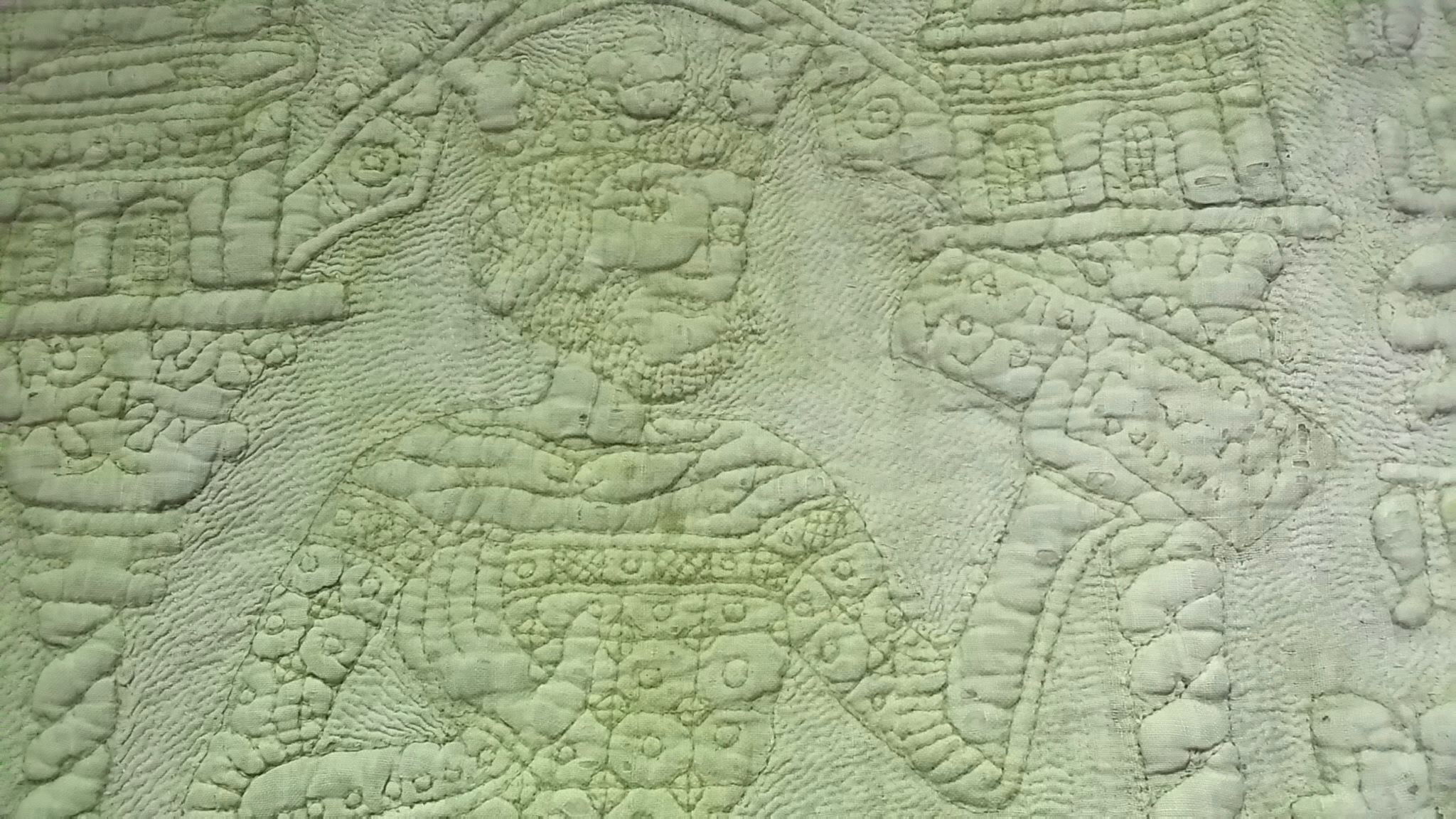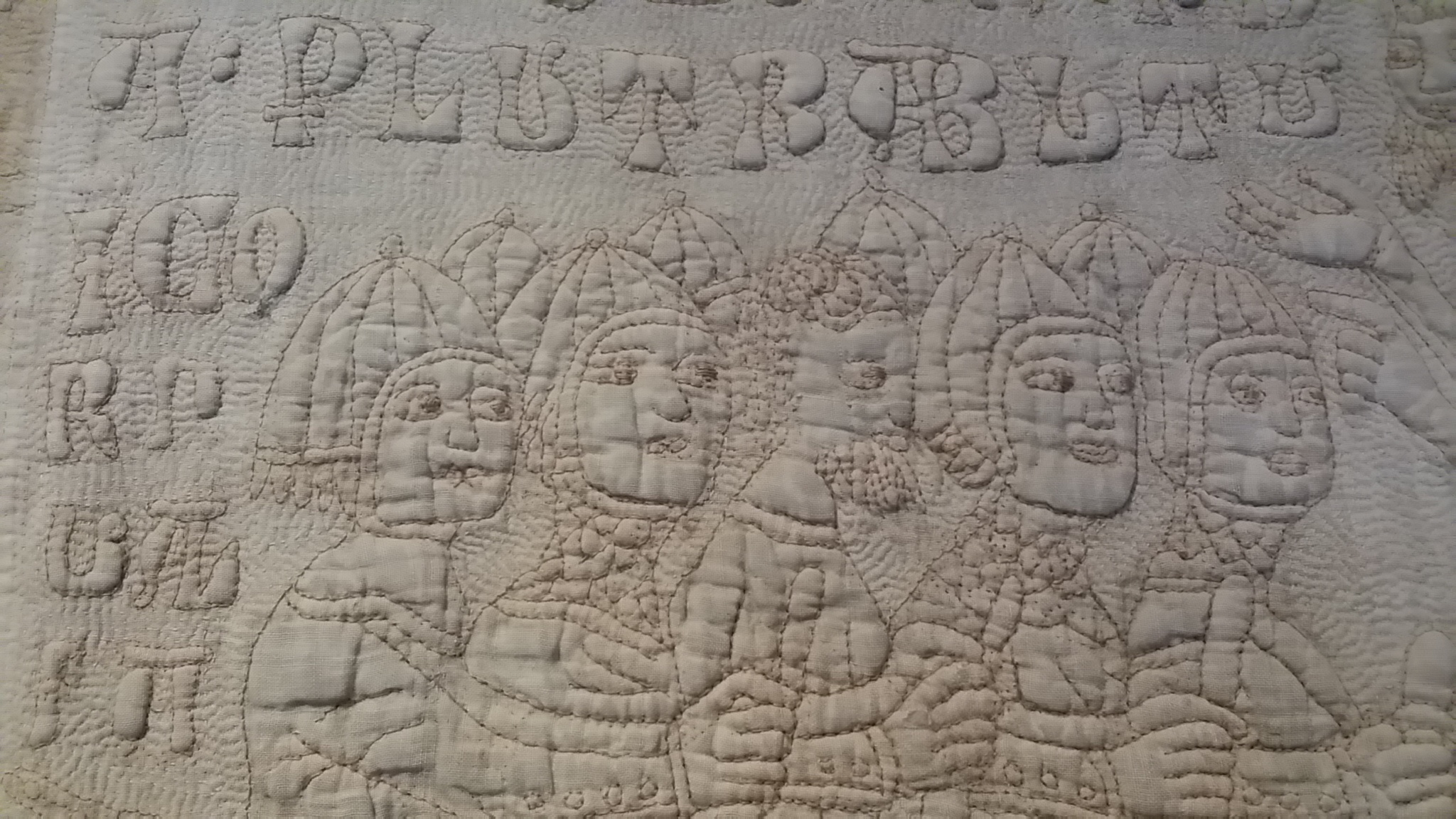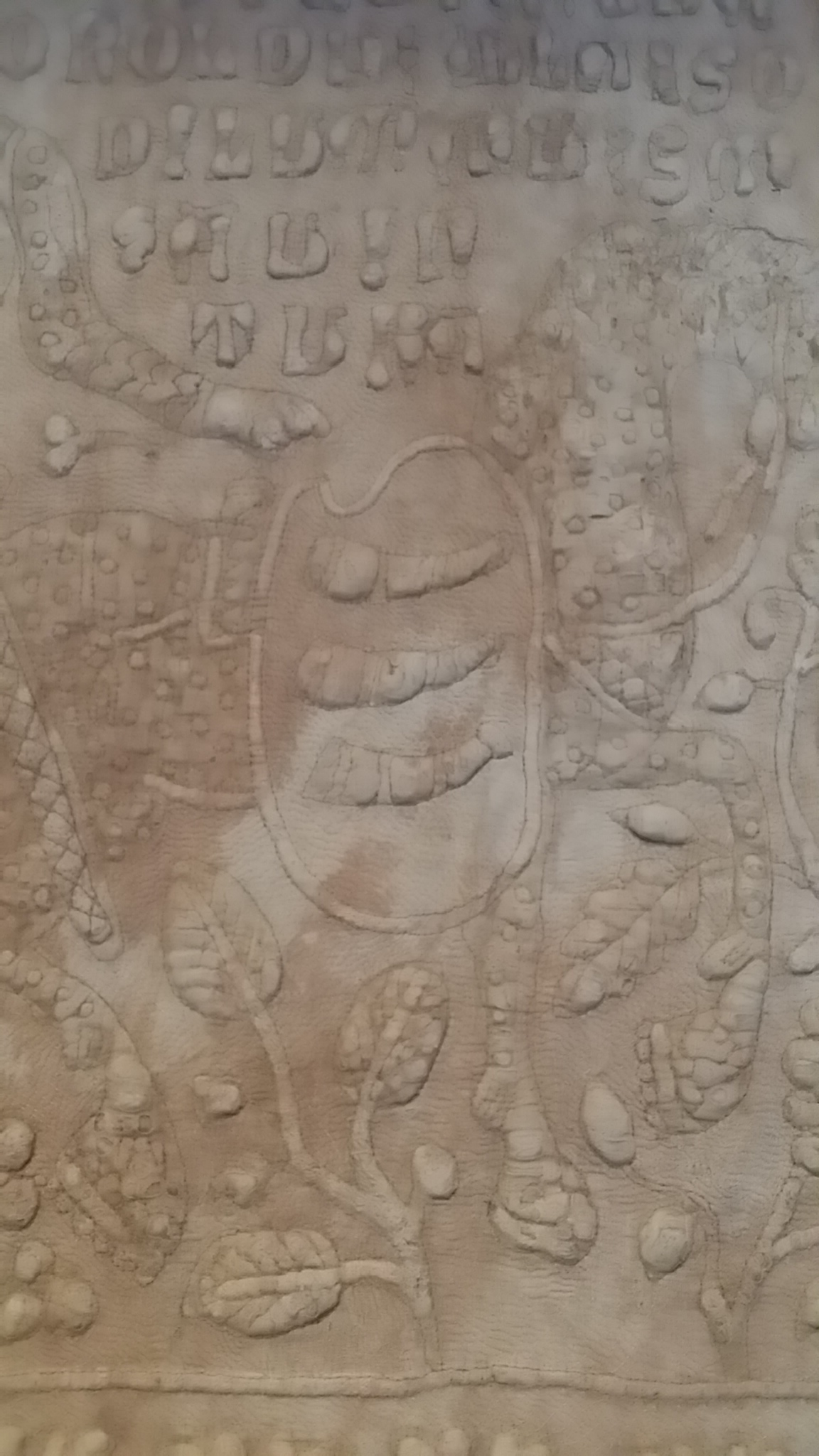Tristan Quilt on:
[Wikipedia]
[Google]
[Amazon]
 The Tristan Quilt, sometimes called the Tristan and Isolde Quilt or the Guicciardini Quilt, is one of the earliest surviving
The Tristan Quilt, sometimes called the Tristan and Isolde Quilt or the Guicciardini Quilt, is one of the earliest surviving
Accessed 7-02-2010 Depicting scenes from the story of ''
in the collections of the Victoria and Albert Museum, London. Accessed 5-2-2010 There are at least two extant sections of the quilt, one of which is displayed in the
 The quilt is made from two layers of linen, stitched together with
The quilt is made from two layers of linen, stitched together with


 The imagery on the quilt resembles the narrative of chapters 17–19 of a 14th-century novella, ''La Tavola Rotonda o L'Istoria di Tristano'', which describes the oppression of Cornwall by Languis of Ireland and his champion Amoroldo (a variation on "
The imagery on the quilt resembles the narrative of chapters 17–19 of a 14th-century novella, ''La Tavola Rotonda o L'Istoria di Tristano'', which describes the oppression of Cornwall by Languis of Ireland and his champion Amoroldo (a variation on "
 It was long believed that the quilts were made to be given as a wedding gift to Pietro di Luigi Guicciardini and Laodomia Acciaiuli in 1395. although recent research suggests an earlier date. The three hunting horns on Tristan's shield are the
It was long believed that the quilts were made to be given as a wedding gift to Pietro di Luigi Guicciardini and Laodomia Acciaiuli in 1395. although recent research suggests an earlier date. The three hunting horns on Tristan's shield are the
 The Tristan Quilt, sometimes called the Tristan and Isolde Quilt or the Guicciardini Quilt, is one of the earliest surviving
The Tristan Quilt, sometimes called the Tristan and Isolde Quilt or the Guicciardini Quilt, is one of the earliest surviving quilts
A quilt is a multi-layered textile, traditionally composed of two or more layers of fabric or fiber. Commonly three layers are used with a filler material. These layers traditionally include a woven cloth top, a layer of batting or wadding, a ...
in the world.The Tristan and Isolde QuiltAccessed 7-02-2010 Depicting scenes from the story of ''
Tristan and Isolde
Tristan and Iseult, also known as Tristan and Isolde and other names, is a medieval chivalric romance told in numerous variations since the 12th century. Based on a Celtic legend and possibly other sources, the tale is a tragedy about the illic ...
'', an influential romance and tragedy, it was made in Sicily
(man) it, Siciliana (woman)
, population_note =
, population_blank1_title =
, population_blank1 =
, demographics_type1 = Ethnicity
, demographics1_footnotes =
, demographi ...
during the second half of the 14th century.The Tristan Quiltin the collections of the Victoria and Albert Museum, London. Accessed 5-2-2010 There are at least two extant sections of the quilt, one of which is displayed in the
Victoria and Albert Museum
The Victoria and Albert Museum (often abbreviated as the V&A) in London is the world's largest museum of applied arts, decorative arts and design, housing a permanent collection of over 2.27 million objects. It was founded in 1852 and nam ...
's Medieval and Renaissance Galleries, and the other in the Bargello
The Bargello, also known as the Palazzo del Bargello, Museo Nazionale del Bargello, or Palazzo del Popolo (Palace of the People), was a former barracks and prison, now an art museum, in Florence, Italy.
Terminology
The word ''bargello'' appears ...
in Florence
Florence ( ; it, Firenze ) is a city in Central Italy and the capital city of the Tuscany Regions of Italy, region. It is the most populated city in Tuscany, with 383,083 inhabitants in 2016, and over 1,520,000 in its metropolitan area.Bilan ...
. A third quilt, also depicting Tristan and Isolde, but not thought to be part of the V&A and Bargello examples, is held in private hands. The Tristan Quilts are the only known surviving intact examples of medieval quilts.
Material and construction
 The quilt is made from two layers of linen, stitched together with
The quilt is made from two layers of linen, stitched together with wadding
Wadding is a disc of material used in guns to seal gas behind a projectile (a bullet or ball), or to separate the propellant from loosely packed shots.
Wadding can be crucial to a gun's efficiency, since any gas that leaks past a projectile as i ...
in between. Backstitch
Backstitch or ''back stitch'' and its variants ''stem stitch'', ''outline stitch'' and ''split stitch'' are a class of embroidery and sewing stitches in which individual stitches are made backward to the general direction of sewing. In embroid ...
in cream and brown linen thread defines a series of pictures with captions that have been brought into relief
Relief is a sculptural method in which the sculpted pieces are bonded to a solid background of the same material. The term '' relief'' is from the Latin verb ''relevo'', to raise. To create a sculpture in relief is to give the impression that th ...
by inserting rolls of cotton
Cotton is a soft, fluffy staple fiber that grows in a boll, or protective case, around the seeds of the cotton plants of the genus '' Gossypium'' in the mallow family Malvaceae. The fiber is almost pure cellulose, and can contain minor pe ...
stuffing to raise sections of the design, a technique known as trapunto. The stuffing could have been introduced during the quilting process, or because the backing layer is looser in weave, its threads could have been parted to introduce the stuffing; some elements are done using cord quilting.
Subjects


 The imagery on the quilt resembles the narrative of chapters 17–19 of a 14th-century novella, ''La Tavola Rotonda o L'Istoria di Tristano'', which describes the oppression of Cornwall by Languis of Ireland and his champion Amoroldo (a variation on "
The imagery on the quilt resembles the narrative of chapters 17–19 of a 14th-century novella, ''La Tavola Rotonda o L'Istoria di Tristano'', which describes the oppression of Cornwall by Languis of Ireland and his champion Amoroldo (a variation on "Morholt
The Knights of the Round Table ( cy, Marchogion y Ford Gron, kw, Marghekyon an Moos Krenn, br, Marc'hegien an Daol Grenn) are the knights of the fellowship of King Arthur in the literary cycle of the Matter of Britain. First appearing in ...
"), and the battle of Tristan
Tristan (Latin/ Brythonic: ''Drustanus''; cy, Trystan), also known as Tristram or Tristain and similar names, is the hero of the legend of Tristan and Iseult. In the legend, he is tasked with escorting the Irish princess Iseult to we ...
on behalf of King Mark of Cornwall
Mark of Cornwall ( la, Marcus, kw, Margh, cy, March, br, Marc'h) was a sixth-century King of Kernow (Cornwall), possibly identical with King Conomor. He is best known for his appearance in Arthurian legend as the uncle of Tristan and the husb ...
. The foliage on the quilt includes ivy
''Hedera'', commonly called ivy (plural ivies), is a genus of 12–15 species of evergreen climbing or ground-creeping woody plants in the family Araliaceae, native to western, central and southern Europe, Macaronesia, northwestern Africa and ...
and grape vines
A grape is a fruit, botanically a berry, of the deciduous woody vines of the flowering plant genus ''Vitis''. Grapes are a non- climacteric type of fruit, generally occurring in clusters.
The cultivation of grapes began perhaps 8,000 years ago, ...
, a reference to the plants that grew and intertwined from the tombs of the doomed Tristan and Isolde. The scenes on the V&A quilt are not in their original order, having been re-arranged at some point. Each scene has a caption in the Sicilian language
Sicilian ( scn, sicilianu, link=no, ; it, siciliano) is a Romance language that is spoken on the island of Sicily and its satellite islands. A variant, ''Calabro-Sicilian'', is spoken in southern Calabria, where it is called Southern Calabro ...
.
There are six scenes in the central section of the V&A quilt, with a border of four-leaf clover
The four-leaf clover is a rare variation of the common three-leaf clover. According to traditional sayings, such clovers bring good luck, though it is not clear when or how this idea began. One early mention of "Fower-leafed or purple grasse" is ...
s:
: 1: Morholt
The Knights of the Round Table ( cy, Marchogion y Ford Gron, kw, Marghekyon an Moos Krenn, br, Marc'hegien an Daol Grenn) are the knights of the fellowship of King Arthur in the literary cycle of the Matter of Britain. First appearing in ...
, bearing a fleur-de-lis
The fleur-de-lis, also spelled fleur-de-lys (plural ''fleurs-de-lis'' or ''fleurs-de-lys''), is a lily (in French, and mean 'flower' and 'lily' respectively) that is used as a decorative design or symbol.
The fleur-de-lis has been used in the ...
shield, is shown shooting with a bow whilst on horseback in a boat. A page
Page most commonly refers to:
* Page (paper), one side of a leaf of paper, as in a book
Page, PAGE, pages, or paging may also refer to:
Roles
* Page (assistance occupation), a professional occupation
* Page (servant), traditionally a young m ...
rows the boat. Caption: ' ("How the Morholt wounded Tristan")
: 2: A castle with a king and queen and a third person looking out, possibly Languis and Lotta and their daughter Isolde waiting for Morholt. Partial caption: ' ("...in Ireland")
: 3: Tristan, with a three-horned shield, fights Morholt on an island. Caption: ' ("How Tristan wounded Morholt in the head")
: 4: A page with a saddled horse. Caption: ' ("How the Morholt's page waited for his master")
: 5: A ship being pushed away by Tristan's foot. Caption: ' ("How Tristan struck his boat behind him into the sea")
: 6: Tristan with his horse and shield. Caption: ' ("How Tristan awaits Morholt on the isle Sanza Ventura in the sea")
There are also eight scenes in the border. Along the lower edge are two scenes:
: 7: Mark of Cornwall
Mark of Cornwall ( la, Marcus, kw, Margh, cy, March, br, Marc'h) was a sixth-century King of Kernow (Cornwall), possibly identical with King Conomor. He is best known for his appearance in Arthurian legend as the uncle of Tristan and the husb ...
receives a letter from two kneeling ambassadors while Tristan stands behind them. Caption:' ("How the ambassadors are come to King Mark for the tribute of seven years")
: 8: The ambassadors, in a ship rowed by soldiers and bearing a fleur-de-lis
The fleur-de-lis, also spelled fleur-de-lys (plural ''fleurs-de-lis'' or ''fleurs-de-lys''), is a lily (in French, and mean 'flower' and 'lily' respectively) that is used as a decorative design or symbol.
The fleur-de-lis has been used in the ...
banner. Caption: ' ("How Languis sent to Cornwall for the tribute")
On the left side, from the top:
: 9: A ship, bearing fleur-de-lis banners with a man blowing a boatswain's call in the poop deck
In naval architecture, a poop deck is a deck that forms the roof of a cabin built in the rear, or " aft", part of the superstructure of a ship.
The name originates from the French word for stern, ''la poupe'', from Latin ''puppis''. Thus ...
. Caption: ' ("How Morholt came to Cornwall with forty galleys")
: 10: Tristan giving his glove to Morholt. Caption: ' ("How Tristan gives the glove of battle to Morholt")
: 11: A Cornish noble
A noble is a member of the nobility.
Noble may also refer to:
Places Antarctica
* Noble Glacier, King George Island
* Noble Nunatak, Marie Byrd Land
* Noble Peak, Wiencke Island
* Noble Rocks, Graham Land
Australia
* Noble Island, Gr ...
paying money to seven of Morholt's men. Caption: ' ("How Morholt made the people pay")
On the right side, from the top:
: 12: A ship bearing a fleur-de-lis banner with Morholt in the poop deck with a man blowing a boatswain's call. Caption: ' ("How Morholt comes to Cornwall")
: 13: King Languis, with three nobles behind him, gives a letter to two kneeling ambassadors, while Morholt stands behind them. Caption: ' ("How King Languis ordered that the host should go to Cornwall")
: 14: Morholt, with a mace, with a herald
A herald, or a herald of arms, is an officer of arms, ranking between pursuivant and king of arms. The title is commonly applied more broadly to all officers of arms.
Heralds were originally messengers sent by monarchs or noblemen to ...
blowing a trumpet
The trumpet is a brass instrument commonly used in classical and jazz ensembles. The trumpet group ranges from the piccolo trumpet—with the highest register in the brass family—to the bass trumpet, pitched one octave below the standard ...
. Caption: ' ("How Morholt made the host go to Cornwall")
The Bargello quilt has eight scenes and is made from three longitudinal strips joined together. Some of the scenes on the Bargello quilt portray Tristan leaving his foster-father's court to go to Mark of Cornwall; the meeting of Tristan with Morholt for combat; and their fight on horseback.
A third quilt in a private collection, thought to be from the same atelier but not actually part of these two quilts, includes a central medallion showing Tristan and Isolde on a field of fleur de lis.
Dimensions
The V&A quilt measures 320 cm high by 287 cm wide. These measurements were verified in 2006 when it was prepared for display in the new Medieval and Renaissance Galleries. The Bargello quilt measures 2.47m high by 2.07m wide.Purpose
Recent research has suggested that the quilts were made as a pair of wall hangings, and subsequently altered. Some sources state that there was a third quilt, believed to have been made for the royalCapetian House of Anjou
The Capetian House of Anjou or House of Anjou-Sicily, was a royal house and cadet branch of the direct French House of Capet, part of the Capetian dynasty. It is one of three separate royal houses referred to as ''Angevin'', meaning "from Anjou" ...
. This third fragment, known as the Pianetti or Azzolini quilt, is in private hands and is thought to come from the same source as the V&A and Bargello quilts.
The textile historian Sarah Randles argues that the two quilts were originally one large quilt, measuring a monumental 6 metres high by 4 metres wide, and that significant sections are missing. Randles' plan for the quilt suggests that the scenes would have been arranged clockwise in the border, with the central images paired and reading bottom to top. Ultraviolet
Ultraviolet (UV) is a form of electromagnetic radiation with wavelength from 10 nm (with a corresponding frequency around 30 PHz) to 400 nm (750 THz), shorter than that of visible light, but longer than X-rays. UV radiation ...
light tests on the Bargello quilt revealed traces of calcium on the reverse, which could have come from its use as a wall hanging, though such use may not have been the original intention.
History
 It was long believed that the quilts were made to be given as a wedding gift to Pietro di Luigi Guicciardini and Laodomia Acciaiuli in 1395. although recent research suggests an earlier date. The three hunting horns on Tristan's shield are the
It was long believed that the quilts were made to be given as a wedding gift to Pietro di Luigi Guicciardini and Laodomia Acciaiuli in 1395. although recent research suggests an earlier date. The three hunting horns on Tristan's shield are the coat of arms
A coat of arms is a heraldic visual design on an escutcheon (i.e., shield), surcoat, or tabard (the latter two being outer garments). The coat of arms on an escutcheon forms the central element of the full heraldic achievement, which in its ...
of the Guicciardini family. The inventories of the Guicciardini family do not include a definitive reference to the quilts, but do mention "three quilted bedcovers".
The V&A quilt, according to its museum number (1391-1904), was acquired in 1904.
The Bargello acquired their quilt in July 1927 from Count Paolo Guicciardini, to whose family it is believed the quilt had always belonged.
References
{{Tristan and Iseult Arthurian art Quilts Medieval textile design Collections of the Victoria and Albert Museum Culture of Sicily